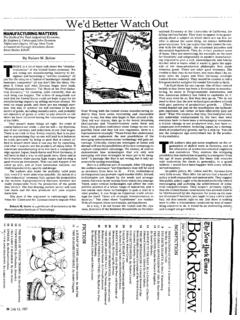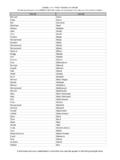Transcription of Robert Halpern Chicago, IL 60611 - The After …
1 Robert HalpernErikson Institute for Advanced Study in Child Development420 North WabashChicago, IL 60611 For additional copies, please contactThe After School Project180 West 80th StreetNew York, NY 10024e-mail: by Amy Janello. Cover photo by Eli Reed/Magnum Photos. PHYSICAL (IN)ACTIVITY Among Low-Income Children and YouthBy Robert HalpernPrepared for the After School Project of the Robert Wood Johnson FoundationProblem, Prospect, ChallengePHYSICAL (IN)ACTIVITY Among Low-Income Children and YouthPrepared for the After School Project of the Robert Wood Johnson FoundationProblem, Prospect, ChallengeBy Robert Halpern , Erikson Institute for Graduate Study in Child Development If left to choose, children instinctively seek the joy of movement.
2 Pete Egoscue (1998)Ferdinando Scianna/Magnum PhotosWHEN TODAY SADULTS REACH BACKIN THEIR MINDS TO CHILDHOOD,their strongest memories ofteninclude physical ones running, skipping, bicy-cling, playing ball, jumping rope, chasing andbeing chased. Being physically active was a definingdimension of urban or suburban childhood for atleast the first two thirds of the twentieth the past twenty or so years, that has becomeless and less the case, and in the past few yearsphysical inactivity among children has come to beviewed as a distinct social problem.
3 In this paper, I examine the reasons for what someare calling an epidemic of inactivity among low- andmoderate-income children and youth and discusswhat it might take to address this problem. I exam-ine the potential roles of After -school and youth programs and of organized youth sports, as well assuch broader responses as renewing outdoor playand recreation spaces and reinstating recess in basic argument is that in developing policies,programs, and a research agenda to address physicalinactivity, we have to keep in mind that the prob-lem has multiple, intertwined roots in unfriendlyand unhealthy physical environments; economicpressures on (and necessary priorities of ) low-income families.
4 The growing institutionalization ofchildhood; unbridled advertising; damaging mes-sages from popular culture; rampant consumerism;the often unhealthy way in which American society does sports; and not least, dysfunctional publicpolicies in a wide range of spheres ( , support forworking families, urban planning, environmentalpolicy, organization of the school day, regulation ofbusiness, etc.). This multi-causality does not meanthat discrete responses such as promoting youthsports are destined to be ineffectual.
5 The mostuseful responses to complex problems are oftenfocused. Moreover, the development of one responseoften leads to awareness of the need for and subse-quent development of others. At the same time, it does not make sense to invest in particular cor-ners of children s lives without worrying about theother PHYSICAL ACTIVITYT erry Lorant/Team Up for YouthUnited Way of Massachusetts BayTerry Lorant/Team Up for YouthPHYSICAL (IN)ACTIVITY 3 PHYSICAL ACTIVITY IS A BROAD AND HETEROGENEOUSCONCEPT. It encompasses both organized activities andinformal ones, games and play, sports and arts, basicallywhatever stimulates movement from physical education andrecess at school to dance classes; dancing at a rock concert toroaming the neighborhood; jumping rope; playing hopscotchand tag; wrestling and tussling with friends; or practicingCapoeira.
6 It is sometimes deliberate, sometimes spontaneous,sometimes the point and sometimes a activity has important developmental meaning of, motivation for, and nature of physical activitychange as individuals move through childhood and the age of eight or nine, children naturally explore andinteract with the world physically as well as verbally, oftenthrough the medium of play. Physical activity (and being physi-cal) is almost not a separate thing, but rather how the self iscomposed and expressed, how learning occurs, how childrenexplore and master the external world.
7 Children are pro-grammed by nature to be little whirling dervishes (Egoscue,1998, p. Y29). The exhilaration, risk, and loss of control associ-ated with movement are sources of pleasure. In her study of chil-dren s play behavior on the school playground, Thorne (1993, ) was struck not only by kids rapid movements but also bytheir continual engagement with one anothers bodies pok-ing, pushing, tripping, grabbing a hat or She noted thatchildren did not seem to experience these intrusions as antago-nistically as adults might the later years of middle childhood and into adolescence,physical activity not only declines in absolute amount,1but isshaped by different factors.
8 What was natural and instinctivehas, in many respects, to be re-learned and physically active becomes a matter of social learning andan element of identity development, as children look (and listen)to others as models of who and what they might be and howthey should engage the world. These models include: parents,relatives, other adults in the community, siblings and friends,and increasingly, popular culture. For example, parents own par-ticipation, enjoyment, and valuing of physical activity serve as animportant influence on their children (Weiss, 2000).
9 Physical activity is strongly shaped by gender. There aregender differences in or perhaps gender stereotypes about the types of physical activity that boys and girls view asacceptable for themselves, and in their perceptions of theirlikely competence in particular activities (Lee, Fredenberg,Belcher & Cleveland, 1999). Parents and children themselvesbelieve that boys and girls have different natural both boys and girls cite having fun, being withfriends, and developing physical skills and/or fitness as themain reasons for participating in organized physical activities,boys have been found to be more competitively oriented andgirls more goal oriented in their approach to such respect to space, boys tend to define and use larger fixedspaces for organized games and sports.
10 Girls define smallerspaces and use them more flexibly. Physical activity is also strongly shaped by social class andrace. These circumstances shape the physical environments inwhich children grow up, the resources to which they have access,the goals of organized activities for children, parental priorities,and a host of other factors. For instance, close to three quartersof African American children in the United States grow up in racially segregated, densely settled and geographically restricted neighborhood environments with little or no safe, usable out-1 Between the ages of 6 and 18, boys reportedly decrease physical activity by 24 percent, girls by 36 percent (Baker et al, 1997, p.)







